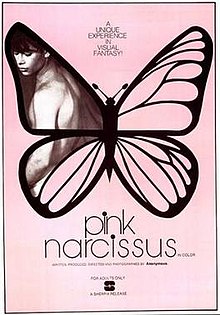fiction.wikisort.org - Movie
Pink Narcissus is a 1971 American arthouse drama film directed by James Bidgood[2] and starring (unknowns) Bobby Kendall, Don Brooks and stage actor Charles Ludlam. It visualizes the erotic fantasies of a gay male prostitute.
This article needs additional citations for verification. (September 2014) |
| Pink Narcissus | |
|---|---|
 | |
| Directed by | James Bidgood |
| Written by | James Bidgood |
| Produced by | James Bidgood |
| Starring | Bobby Kendall Charles Ludlam[1] |
| Cinematography | James Bidgood |
| Edited by | Martin Jay Sadoff |
| Music by | Martin Jay Sadoff Gary Goch |
| Distributed by | Sherpix Inc Strand Releasing (2003 re-release) |
Release date |
|
Running time | 71 minutes |
| Country | United States |
| Language | English |
| Budget | $27,000 (estimated) |
Premise
Between visits from his keeper, or John, a handsome male prostitute (Bobby Kendall), alone in his apartment, lounges, fantasizing about worlds where he is the central character. For example, he pictures himself as a matador, a Roman slave boy and the emperor who condemns him, and the keeper of a male harem for whom another male performs a belly dance.
Production
The film is mostly shot on 8 mm film[3] with bright, otherworldly lighting and intense colors. Aside from its last, climactic scene, which was shot in a downtown Manhattan loft, it was produced in its entirety (including outdoor scenes) in Bidgood's small New York City apartment over a seven-year (from 1963 to 1970) period and ultimately released without the consent of the director, who therefore had himself credited as Anonymous. He said in an interview, "See, why I took my name off of it was that I was protesting, which I'd heard at the time that's what you did..."[3]
Provenance
Because the name of the filmmaker was not widely known, there were rumors that Andy Warhol was behind it.[1] In the mid-1990s, writer Bruce Benderson began a search for its maker based on several leads and finally verified that it was James Bidgood, who was still living in Manhattan and was working on a film script.[4] In 1999, a book researched and written by Benderson was published by Taschen about Bidgood's body of photographic and filmic work.
Bidgood's unmistakably kitschy style has later been imitated and refined by artists such as Pierre et Gilles.[citation needed]
In 2003, the film was re-released by Strand Releasing as the film had its 35th anniversary in 2006.[1]
Music
- Joseph Haydn: Horn Concerto No. 1
- Modest Mussorgsky: Pictures at an Exhibition
- Modest Mussorgsky: Night on Bald Mountain
- Sergei Prokofiev: Alexander Nevsky
- Kenneth Gaburo: "Lemon Drops"
- Genaro Nunez, Banda Taurina, Rosalio Juarez: "Corazon Hispano"
See also
- List of American films of 1971
References
- Edgecomb, Sean Fredric (May 1, 2006). "Camping out with James Bidgood: The Auteur of Pink Narcissus Tells All". brightlightsfilm.com. Retrieved June 20, 2018.
- Genzlinger, Neil (February 7, 2022). "James Bidgood, a Master of Gay Photography, Dies at 88 - In addition to his elaborately staged images of gay fantasies, he made the film "Pink Narcissus," a cult classic released anonymously in 1971". The New York Times. Retrieved February 8, 2022.
- Gallagher, Paul (July 4, 2011). "James Bidgood's Sumptuous and Subversive 'Pink Narcissus', 1971". dangerousminds.net. Retrieved June 20, 2018.
- Benderson, Bruce (1999). James Bidgood. Benedikt Taschen Verlag. ISBN 3-8228-7427-2.
External links
- Pink Narcissus at IMDb
- Pink Narcissus at AllMovie
Другой контент может иметь иную лицензию. Перед использованием материалов сайта WikiSort.org внимательно изучите правила лицензирования конкретных элементов наполнения сайта.
WikiSort.org - проект по пересортировке и дополнению контента Википедии